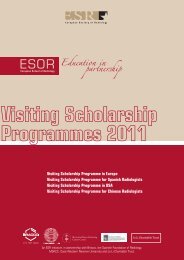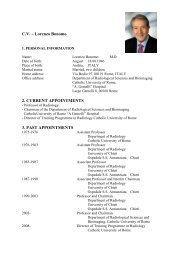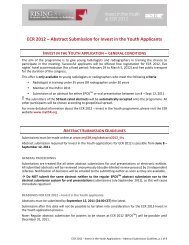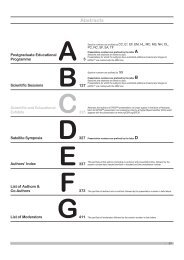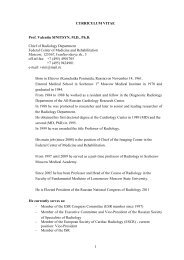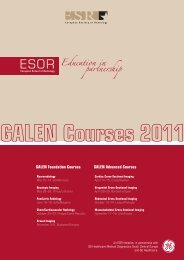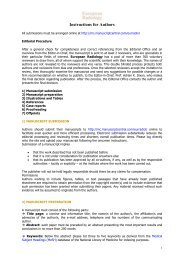<strong>Postgraduate</strong> <strong>Educational</strong> <strong>Programme</strong>A-189 16:51C. Portal vein embolisation before surgeryA. Denys, P. Bize; Lausanne/CH (Alban.Denys@chuv.ch)Portal vein embolisation (PVE) is performed before hepatectomy. Portal branchesof segments that will ultimately be resected are embolized. This embolisationproduces local per-portal inflammation and reroutes the portal flow towards segmentsthat will be left in place by the surgeon inducing liver regeneration of thesesegments. Indications are mainly hepatectomies removing more than 70-80% ofthe functional liver in healthy liver of more than 50-60% when the liver has beenharmed either by a chronic liver disease or cirrhosis or by chemotherapy or steatosis.The procedure is done percutaneously and different embolic agents can be usedfor PVE, such as embolic particles, coils and plugs. Results from experimentalworks suggest that PVE is more efficient when embolic agent occludes smallportal branches and produces significant periportal inflammation. PVE indicationsas well as results are evaluated by CT volumetry of the liver either manually orautomatized by dedicated algorithms.Learning Objectives:1. To become familiar with imaging strategies and indications for embolisation.2. To understand embolisation methods.3. To learn about results, complications and follow‐up strategies.Author Disclosure:A. Denys: Advisory Board; Bayer. Grant Recipient; Biocompatibles, Cook,Terumo. P. Bize: Advisory Board; Bayer. Grant Recipient; Biocompatibles, Cook,Terumo.Panel discussion:How to allow for more patients with HCC to be treated? 17:1416:00 - 17:30 Room PRadiographersRC 714Clinical audit: from EURATOM to the clinicalenvironmentModerators:E.J. Adam; London/UKD. Pronk‐Larive; Middelburg/NLA-190 16:00A. Clinical audit: from the EURATOM treaty to EU guidelines: clinicalaudit RP 159P. Wood; Helsinki/FI (paivi.wood@suomenrontgenhoitajaliitto.fi)The EC directive 97/43/EURATOM introduced the concept of Clinical Audit forthe assessment of radiological practices. The Member States were required toimplement clinical audits in accordance with national procedures. This conceptis of high importance for the improvement of the quality of imaging practices.In the past years, the implementation of clinical audits has been commenced ina number of varying “national procedures”. Need for guidance was obvious toachieve meaningful results. In 2007-2008, the EC conducted a project to prepareguidance on clinical audit. The purpose of the project was to provide clear andcomprehensive information on existing procedures and criteria for clinical auditsin radiological practices. The final European Guidelines were published in June2009. The EC guideline is to provide guidance on clinical auditing in order toimprove implementation of Article 6.4 of Council Directive 97/43/ EURATOM. Theguideline provides comprehensive information on existing procedures and criteriafor clinical audit in radiological practices: diagnostic radiology, nuclear medicineand radiotherapy. Clinical audit is not research, quality system audits nor regulatoryinspections and it is systematic and planned activity. Clinical audit is a systematicreview of medical radiological procedures which seeks to improve the quality andthe outcome of patient care through structured review. Clinical audit should be amulti-disciplinary, multi-professional activity. Follow general accepted rules andstandards which are based on international, national or local legal regulations,or on guidelines developed by international, national or local medical and clinicalprofessional societies.Learning Objectives:1. To understand the background to the publication of RP 159 along withits purpose and scope.2. To become familiar with the principles and prerequisites of clinical audit asoutlined by RP 159.3. To become familiar with the relationship between clinical audit and regulatorycontrols.4. To gain an insight into potential national, regional and international issuesassociated with clinical audit.Author Disclosure:P. Wood: Advisory Board; European Commission project 2007-2008 ContractN TREN/07/NUCL/S07. 71512, Panel of Experts Member. CEO; Society ofRadiographers in Finland. Consultant; Qulitor Ltd, clinical audits.A-191 16:30B. Implementation in practice: a comparison of different modelsS. Geers‐van Gemeren; Utrecht/NL (s.geers@nvmbr.nl)The Dutch Society of Medical Imaging and Radiotherapy (NVMBR) has implementedclinical audit in 1999 for the fields radiology, nuclear medicine and radiotherapy.In the Netherlands, clinical audit is since 2010 obligatory for healthcare professions,regulated by law, to be able to practice. With clinical audit the quality of the provisionof care by professionals is assessed by peers. In 1999, the NVMBR startedwith clinical audit. The NVMBR audit radiographers working in the Radiology andNuclear Medicine departments every five years on request. For the radiotherapy,a multidisciplinary audit is developed since 2003. Pilots of multidisciplinary auditshave been performed for radiology in 2004 and for nuclear medicine in 2010 and2012. The evaluation of the pilots shows a benefit for the department and for theprofessional groups. Implementation: in 2008, the NVMBR started with a webbasedtool ADAS (General Digital Audit System) to support the audit. The use ofADAS is evaluated amogst the members of the audit team and the departments.The development of professional standards is a prerequisite to start clinical audit.The use of ADAS in multidisciplinary audits is a requirement to be able to auditdifferent professions and focus on the content and the quality of their contributionto patient care. Clinical audit is a good tool to improve the quality of patient care.Important are the professional standards, the culture of learning and willing toimprove by the professionals. „Every defect is a treasure“.Learning Objectives:1. To understand the key components required to allow clinical audit to be implementedin practice.2. To gain an insight into different implementation models.3. To be informed about the key considerations that must be made prior toimplementing an audit model: <strong>org</strong>anisation, auditors, process, financing, theroles of professional bodies, and outcomes.A-192 17:00C. A perspective on the impact and benefits of clinical auditS. O’Connor; Dublin/IE (s.oconnor@globaldiagnostics.ie)The purpose of this lecture is to demonstrate how systematic clinical audit can beembedded in a radiology department and to provide practical insight and adviceon audit selection and implementation and how to achieve critical buy in from amulti-disciplinary team to ensure that clinical audit remains an integral and selfsustainingcomponent of a modern radiology service. The importance of appropriateresources and training will be discussed in tandem with review of current literatureand guidelines available in this field. The findings, actions and outcomes will beevaluated to demonstrate the tangible and beneficial impact audits can have onpatients, the team and the service delivery. Clinical Audit remains one of mostimportant ways we have to ensure the quality of the service we provide. Whenimplemented properly, it will result in an effective and efficient quality-assured andsafe radiology service. The service must be delivered by a committed team ofinformed clinicians and will underpin an optimised patient journey.Learning Objectives:1. To gain an insight into the use of clinical audit from the perspective of a clinicalaudit lead in an international diagnostic imaging service provider.2. To become familiar with the challenges that may be encountered when undertakingclinical audit.3. To understand the significant impact that clinical audit can have from theperspective of the patient, the healthcare team and on service delivery.S48AB C D E F G
<strong>Postgraduate</strong> <strong>Educational</strong> <strong>Programme</strong>16:00 - 17:30 Room QSpecial Focus SessionSF 7cImaging in intensive care patientsA-193 16:00Chairman’s introductionA. Palkó; Szeged/HU (palkoand@gmail.com)Intensive care units are special places where everything happens very fast andmost decisions taken are influencing not only the healing but also the survivalof the patient; while the amount of available information supporting these decisionsis frequently rather limited. Results of imaging examinations are thereforeof very high importance, however, the extraordinary circumstances both in termsof technical conditions and in state of the patients challenge the expertise ofthe radiology department. Radiologists cooperating with intensive care specialistsmust understand the unique constraints in this environment and be awareof the clinical significance of their reports. Imaging diagnostic algorithms andexamination techniques are to be flexibly adapted to the clinical situation and afast and close communication of and consultation about the imaging findings isa basic requirement. Speakers of this session will address these general topicsthrough the most challenging specific areas of imaging the intensive care patients.Session Objectives:1. To understand the importance of imaging diagnostics in the unique and challengingclinical setting of the intensive care units.2. To learn about the technical and methodological considerations to be takeninto account with this patient group.3. To learn more about the most important conditions and the imaging findingsas well as the diagnostic imaging algorithms to be used in the intensive careenvironment.Author Disclosure:A. Palkó: Advisory Board; Euromedic Intl. Consultant; Covidien.A-194 16:05Value of MRI for intensive care coma patients with unclear brain pathologyP.C. Maly Sundgren; Lund/SE (Pia.Sundgren@med.lu.se)second focus will be to outline key features helpful for differential diagnosis becauseCT of the lung - similarly as radiography - frequently suffers from the fact that thepattern of lung reaction to inflammatory/infectious noxa is quite nonspecific. Takingthese two goals into consideration, the following four pathologic situations will bediscussed: pneumonia and complications, ARDS staging and signs of barotrauma,oedema and its differentialdiagnosis, and post-surgical conditions: normal versuspathologic findings.Learning Objectives:1. To understand the spectrum of pathological lung conditions, which complicateintensive care treatment.2. To learn about the role of diagnostic imaging and its technical difficulties andrequirements in the intensive care environment.3. To become familiar with the most important imaging signs and symptoms oftracheobronchial and lung conditions, influencing the treatment and survivalof the intensive care patient.A-196 16:41Point-of-care versus diagnostic ultrasound in the intensive care unitE. Danse, P.‐F. Laterre, L. Jacquet, A. Dragean, I. Nica, P. Trefois, L. Annet;Brussels/BE (etienne.danse@uclouvain.be)This topic will be focused on the role of sonography in the critical care. Point caresonography is mainly dedicated to procedural guidance (vessels access or fluidpunction) or assessement of fluid in the pleural space or the abdominal cavity (forinstance, FAST sonography in trauma patients). This “ultrasonic” stethoscope ismore and more popular due to its miniaturisation at low cost. Diagnostic sonographyhas another medical scope based on the imaging knowledge of radiologists and onthe capabilities of mid-range or high-level machines. The B mode and Color Dopplermodalities are routinely used with additional contribution of contrast ultrasound whenneeded or available. In the intensive care unit, point care or diagnostic sonographyare contributive for the diagnosis work-up of critical care patients, allowing anoptimal use of CT and angiography or an urgent access to the operating room.Learning Objectives:1. To understand the concept and role of point-of-care ultrasound and its technicaland training requirements.2. To become familiar with the role and tasks of diagnostic ultrasound versuspoint-of-care ultrasound in the most common pathologic conditions in intensivecare.3. To learn more about typical ultrasound findings and their significance in thediagnosis, differential diagnosis and therapy of intensive care patients.FridayEvaluation of the degree of severity of injury, coma duration, and prediction ofoutcome are integral parts of the management of patients in coma at the intensivecare unit. Advanced magnetic resonance imaging techniques with special focuson MR spectroscopy (MRS) and diffusion (DWI) but also of the cerebral vascularityin form of different perfusion measurements have shown to be a valuable toolin the work-up or both patients with known as well as unknown cause for coma.The causes for coma are many including infections, metabolic, traumatic and canalso be seen secondary to space occupying brain lesions. The present lecture willfocus the value of different MR imaging techniques and sequences in the work-upof possible cause, monitor treatment and predict outcome in coma patients at theintensive care unit.Learning Objectives:1. To understand the importance of magnetic resonance imaging in cases ofunclear brain pathology causing severe dysfunction of the central nervoussystem.2. To understand the significance of imaging in the evaluation of brain functionand potential outcome following anesthesia, injuries and hypoxia.3. To become familiar with the imaging signs and their predictive value and accuracyregarding brain death, and future role of imaging in decisions concerningthe termination of intensive treatment.Author Disclosure:P. C. Maly Sundgren: Board Member; ISMRM, ASNR. Consultant; ICON MedialImaging.A-195 16:23Computed tomography of pathologic lung conditions complicatingintensive care treatmentC.M. Schaefer‐Prokop; Amersfoort/NL (cornelia.schaeferprokop@gmail.com)Method of choice for imaging the lung of an intensive care patient is the bedsidechest radiograph. CT is only done if complications are anticipated or radiographicfindings are equivocal. One focus of the presentation is, therefore, to outline whichdiagnostic information is added by CT compared to the bedside radiograph. TheA-197 16:59Imaging in polytraumaU. Linsenmaier; Munich/DE (Ulrich.Linsenmaier@kliniken‐pasing‐perlach.de)Management of patients after polytrauma on IC units can be complex and demanding.Clinical diagnoses relay today on a thorough diagnostic workup whichis mostly based on a standardised whole body CT (WBCT). ICU patients undergofollow‐up MDCT to control findings (e.g.in non-operative treatment), new clinicalCT indications arise, CT is often combined with bedside US and CR. RadiologicalManagement of patients with polytrauma: imaging protocol for the initial workup:WBCT comprises nCCT, CMCT of thorax, neck and c-spine (arterial) and (pv) abdomen.CRs were mostly replaced, US is only used as FAST (focused abdominalsolography in trauma). WBCT can be modified by CTA (@35-45s; for e.g. extremityinjuries), late CT scans (@120s; e.g. for bleeding dynamics, pseudoaneurysms)and delayed CT urography (CTU @ 400-500s, for pelvic and GU injuries) and alsoretrograde CT cystography. CT scout views and clinical findings determine theextent. Follow‐up imaging of ICU patients after polytrauma: comprise dedicatedMDCT, US and CR, secondary imaging procedures are MR, MRA (indicated onlyin stable patients) and DSA (e.g. for interventional procedures). Findings from initialWBCT determine how to proceed in a “first things first” priority-oriented clinicalalgorithm. Special considerations apply in imaging MOF, shock, brain oedema andin paediatric and pregnant polytrauma. Radiological findings must be discussed inthe clinical context. Treatment is priority oriented and carefully planned in the contextof possible concomitant injuries, and the possible risk of multi-<strong>org</strong>an failure (MOF).Learning Objectives:1. To appreciate the clinical significance of conditions characterised by multiplesevere injuries and their systemic and multi-<strong>org</strong>an complications.2. To explain the special role of imaging, the diagnostic algorithm and the technical,<strong>org</strong>anisational and training requirements for the diagnosis and follow‐upof polytrauma patients.3. To consolidate knowledge of imaging signs and symptoms and their diagnosticvalue in patients with polytrauma.AB C D E F GS49



